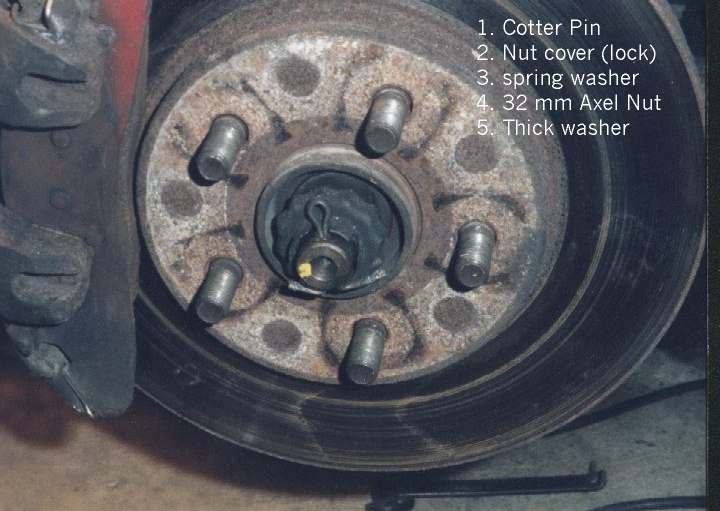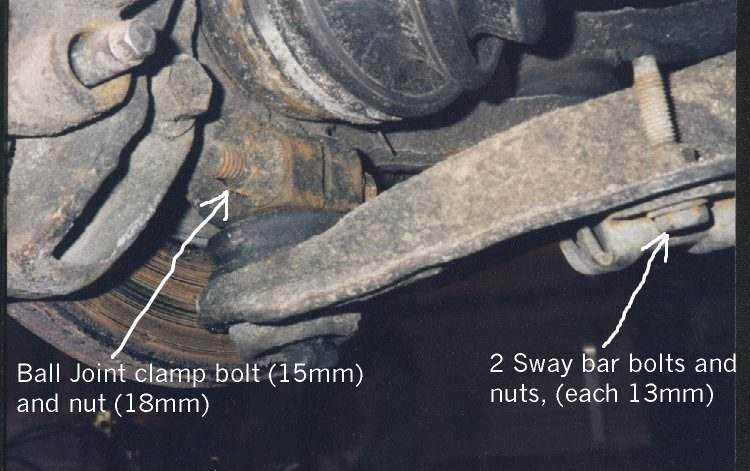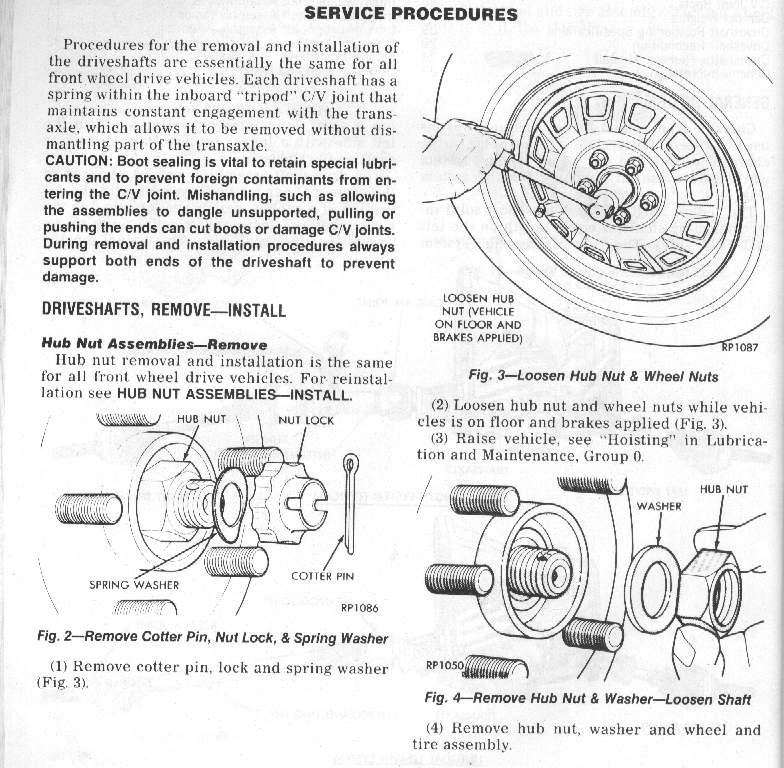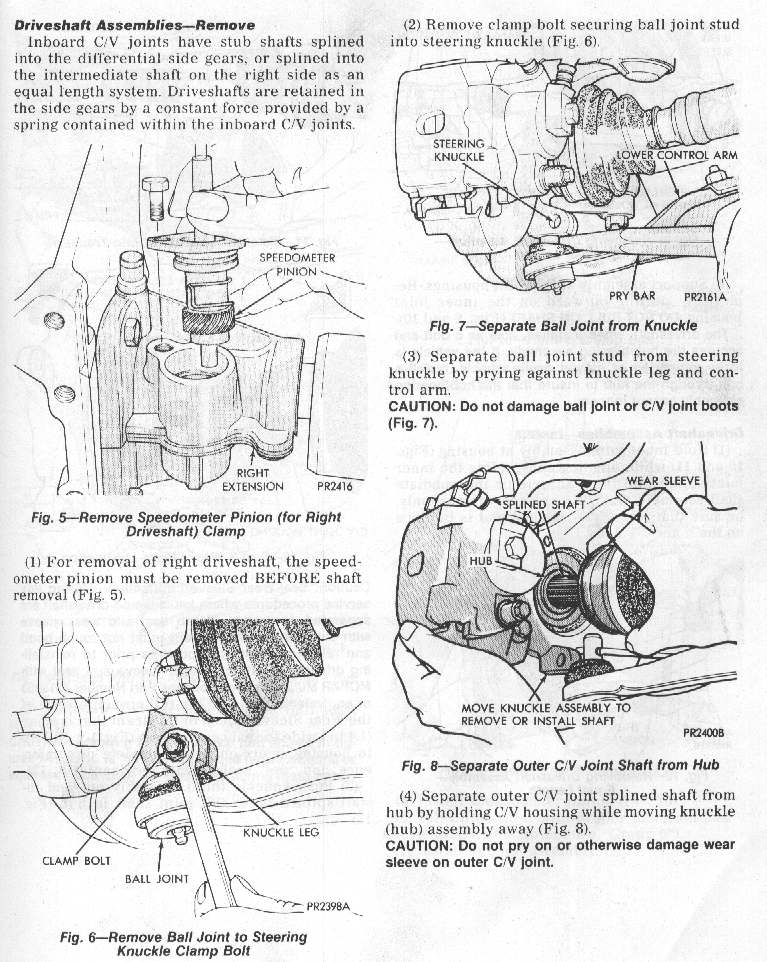Replacing FWD axles in the Dodge Mini Van
This is a step by step approach to replacing the axle (half
shaft, CV joint) on my 89
Dodge Caravan. This should apply to all K based
Dodge Cars without equal length
Axles. The Equal length cars have a short shaft
on the right side between the trans.
output and the Axle to reduce torque steer in High performance
applications. Most
FWD Mopars are Unequal length axles, as are the mini
vans discussed here.
You should have a good have day available for first
time.
Remember, IT REALLY IS EASY. This will take me
about 1 to 2 hours to do.
I have changed them on the side of the road without worry.
Special tools needed:
32 mm socket for the axle retaining
nut.
Jack stands, and a good jack.
Pry bar
4 nuts and bolts, 13 mm head size,
metric
8 mm x 1.25 mm thread, 35 mm long (for sway bar
mount)
(note: some models used larger, 15mm head
size, sway bar bolts with lock tight. Hard to turn)
2 quarts of Mopar 7176 Trans fluid.
13 mm DEEP well socket
13 mm Wrench
15 mm Socket, (deep and shallow)
and wrench
18 mm Socket and wrench
Screw drivers, pliers, pry bars,
hammers, normal stuff
Procedure:
Set parking brake.
Loosen the lug nuts (one turn)
on BOTH wheels.
Jack up the front of the car and
put on jack stands, making sure you are able to remove both front wheels.
Remove both front wheels. (This
is to gain access to the opposite side sway bar bolts) Note, you can get
to the opposite side sway bar bolts without pulling the tire, you just
have better access with both tires out of the way.
Have some one press on the brakes
to keep the front rotors from turning. Remove the cotter pin, nut
locking cover, and spring washer. Remove the large 32 mm axle nut.
It is TIGHT. Remove the thick washer behind the nut. If you do not have
a helper, this nut can be removed while the tires are still on the ground
to keep it from turning. My wheels have a center cap which prevent this.
Remove 4 bolts that hold the sway
bar attached to the lower A frames on both sides of the car. The
bolts (2 each) secure a plate which compresses a rubber insulator which
goes around the end of the sway bar. (see picture below) These bolts
pass all the way through the A frame with 13 mm nuts on top. They
have 13 mm heads on the bolt and 13 mm nuts. They are about 1.5 inches
long. Be prepared to break them off (they are mentioned in the list
of tools required above) as they will rust badly, and should be replace
with new ones anyway.
The sway bar will still be attached
to the "K Frame" . Just push down (may need a pry bar or pipe, if
it keeps springing back up) on the end of the bar, swiveling it down. It
will spin in the rubber bushings, it just may be stuck.
On the side of the car with the
broken axle, locate the lower ball joint. It may have a grease fitting
in it. (see picture below) The ball joint has a vertical "pin" sticking
out the top of it which is attached to the steering knuckle. It sticks
in a hole in the bottom of the knuckle and is clamped in place by a single
horizontal bolt. This bolt has a 15 mm head, and 18 mm nut.
Remove this bolt. It might have to be tapped out if it is stuck. If so,
leave the nut on the very end of the bolt so you don't damage the bolt
threads when you hit it.
Using a hammer, pry bar, crow bar,
or whatever, and pry down on the lower A frame slipping the ball joint
out of the steering knuckle. It should just slide out with a little
force.
Now the strut and steering knuckle
are free of the lower A frame. Swing the Steering knuckle out pulling
the axle out of the hub in the steering knuckle.
Pull the axle out of the transmission.
Some older models have snap rings which hold the axles in, which I think
require you to pry out the axle from the transmission. I have not done
this. Some Trans fluid will leak out of the transaxle when the axle is
removed.
Put the new axle in the transmission
making sure it is fully seated in the transmission.
Put a heavy coating of Grease on the area where the face
of the axle contacts the steering knukle. This is called the wear ring
and wheel bearing seal, and must be full of grease!
Swing the steering knuckle out and
slip the axle splines back into it. (May need some help here)
Put back on the thick washer and
32 mm nut hand tight.
Push, pull, and swing the knuckle
so that the ball joint pin slips back up into the bottom. Put the
bolt back in. If the bolt wont go in, look down through the hole, and adjust
the ball joint pin position with a screw driver or center punch. (a 3/8
inch ratchet extension seems to be perfect for aligning the hole!)
Swing the sway bar back up and bolt
the mount plates on each end back to the Lower A frames on both sides of
the car. You may need to use a jack to raise and hold it up.
Have someone press on the brakes,
and tighten the 32 mm nut to 200 ft pounds.
(If the wrench handle is one foot
long, you need to put 200 pounds of force on it, if it 2 feet long, the
100 pounds, etc.) In other words, damn tight.
Put the spring washer on the axle
nut, and the nut locking cover. Turn this nut cover until the holes line
up with the axle, and put the cotter pin in. bend the ends of the pin over
to keep it from falling out.
Put the tires back on, with the
lug nuts hand tight. Lower the car back to the ground and tighten
the lug nuts tight. Drive it a few miles and recheck the lug nuts and all
other bolts you took off. Check and replace any lost Trans fluid
If the right (passenger side) axle
is to be replaced, the speedometer gear should
be removed. It is held
in place by a 10 mm bolt. The gear is located on the right axle support
housing. Older cars will have the Speedometer cable attached to it.
Remove the bolt, and pull out the
gear. It is held with a O ring, so it might be tight. This is done
before the axle is pulled out so the gear is not damaged during removal
or when the axle is pushed back in the housing. (Note: I have pulled
my axles several times with the speedo gear still in place, being CAREFUL,
and did not hurt the gear)
One last note: A friend of mine who regularly breaks axles has a neat
trick, but it sounds like you must be careful.
He jacks up the car and sets it down on jack stands. Then He has a
special turn buckle that attaches to the
bottom of the jack stand up to the ball joint area of the a frame.
When this turn buckle is tightened, it pulls down
on the A frame, pulling the ball joint free, allowing the axle to be
pulled with out disconnecting the sway bar!




BACK TO HOME
PAGE
Click here
to see the Quickest FWD Mini Van



